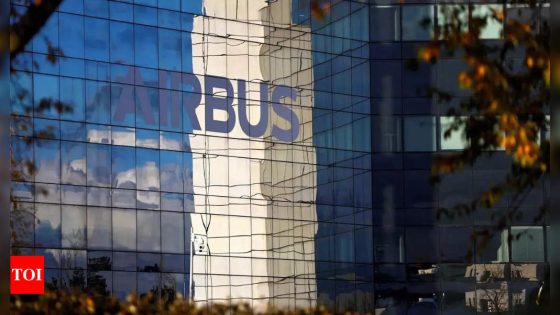MARIGNANE: The production of aviation giant Airbus‘ commercial helicopter, the H125, in India is likely to start in 2026, with the company proceeding to set up a final assembly line (FAL) later this year.
Airbus Helicopters’ executive vice president, Olivier Michalon, stated that the company has shortlisted eight locations, and the final decision on the most suitable one for India’s first aviation assembly line in the private sector will be made soon.
“We are still in the final assessment stage. We should be in a position to announce it shortly,” Michalon said. “We want to be attractive and in an ecosystem that is best suited for employees, logistics, industrial activities, and of course, regulations,” he explained, adding that the delivery of the first Make In India helicopter is expected to start towards the end of 2026.
The Airbus H125 helicopter is currently manufactured at three locations in France, US and Brazil. Airbus said the combined capacity of the three FALs was nearly 220.
Addressing reporters at Marignane in France’s Marseille province, the headquarters of Airbus Helicopters, Michalon expressed that India was the market of the future for helicopters. “We manufacture, sell, and support helicopters. Also, we manufacture, sell, and support solutions. This is what we can provide. ‘Make In India’ solutions,” he remarked.
Airbus announced that the Indian FAL would initially produce ten H125 helicopters a year, with the possibility of increasing production based on demand growth. Michalon emphasized that while ten may not seem a large number initially, production would be ramped up as demand grows. Buoyed by the success of its narrow-body A320 aircraft, Airbus hoped the H125 helicopter would replicate the same growth story. “H125 is our A320,” Michalon stated.
Earlier this year, Airbus announced a strategic partnership with the Tata group to assemble its commercially most successful H125 single-engine helicopters, which can carry up to six people, and its seat configuration can be changed “within 10 minutes” depending on its need and purpose.
According to Airbus Helicopters’ head in India and South Asia, Sunny Guglani, there is a projected demand for about 500 H-125 class single-engine helicopters in the region over the next 20 years. “The market is constrained on the supply side while the demand is growing,” Guglani said.
While there are more than 7,200 H125 helicopters currently flying across the world, including the USA, Guglani mentioned that there are nearly 350 civil and para-public helicopters in India and South Asian countries of Bangladesh, Bhutan, Sri Lanka, and Nepal. Of this, less than 250 are currently in service in India, which, he said, is a very low number considering the population and demography of the country. Michalon, however, added that their projection of 500 helicopters in 20 years was “a bit conservative” while the potential was much greater than that. “I expect India to be as big as the United States for this type of helicopter in terms of yearly demand. So, 500 is a reasonable number,” he said.
Airbus stated that the helicopter can be used for a multitude of purposes including emergency medical services, commercial and business operations, tourism, and aerial law enforcement. The commercial helicopters in India are either used by big conglomerates or for tourism purposes. Airbus said the FAL for H125 helicopters in India will undertake the integration of major component assemblies, avionics and mission systems, installation of electrical harnesses, hydraulic circuits, flight controls, dynamic components, fuel system, and the engine, besides testing, qualification, and delivery to customers. Officials mentioned that a basic model of an H125 helicopter may cost around 3.2 million euros, but Indian buyers will have the option to pay in rupees. Though the regulations in India are a bit restrictive, Michalon said those may soon “lighten up a little bit” and the skies may “open up progressively.” “Either we wait for the skies to fully open up and then it is a big rush by all helicopter manufacturers, or we demonstrate our trust and recognition of the potential of India and be ready to invest,” he added.
Airbus is also setting up a FAL in partnership with Tata Advanced Systems Limited at Vadodara to manufacture C295 transport aircraft for the Indian Air Force.
(The reporter was in Marignane, France on the invitation of Airbus)
Airbus Helicopters’ executive vice president, Olivier Michalon, stated that the company has shortlisted eight locations, and the final decision on the most suitable one for India’s first aviation assembly line in the private sector will be made soon.
“We are still in the final assessment stage. We should be in a position to announce it shortly,” Michalon said. “We want to be attractive and in an ecosystem that is best suited for employees, logistics, industrial activities, and of course, regulations,” he explained, adding that the delivery of the first Make In India helicopter is expected to start towards the end of 2026.
The Airbus H125 helicopter is currently manufactured at three locations in France, US and Brazil. Airbus said the combined capacity of the three FALs was nearly 220.
Addressing reporters at Marignane in France’s Marseille province, the headquarters of Airbus Helicopters, Michalon expressed that India was the market of the future for helicopters. “We manufacture, sell, and support helicopters. Also, we manufacture, sell, and support solutions. This is what we can provide. ‘Make In India’ solutions,” he remarked.
Airbus announced that the Indian FAL would initially produce ten H125 helicopters a year, with the possibility of increasing production based on demand growth. Michalon emphasized that while ten may not seem a large number initially, production would be ramped up as demand grows. Buoyed by the success of its narrow-body A320 aircraft, Airbus hoped the H125 helicopter would replicate the same growth story. “H125 is our A320,” Michalon stated.
Earlier this year, Airbus announced a strategic partnership with the Tata group to assemble its commercially most successful H125 single-engine helicopters, which can carry up to six people, and its seat configuration can be changed “within 10 minutes” depending on its need and purpose.
According to Airbus Helicopters’ head in India and South Asia, Sunny Guglani, there is a projected demand for about 500 H-125 class single-engine helicopters in the region over the next 20 years. “The market is constrained on the supply side while the demand is growing,” Guglani said.
While there are more than 7,200 H125 helicopters currently flying across the world, including the USA, Guglani mentioned that there are nearly 350 civil and para-public helicopters in India and South Asian countries of Bangladesh, Bhutan, Sri Lanka, and Nepal. Of this, less than 250 are currently in service in India, which, he said, is a very low number considering the population and demography of the country. Michalon, however, added that their projection of 500 helicopters in 20 years was “a bit conservative” while the potential was much greater than that. “I expect India to be as big as the United States for this type of helicopter in terms of yearly demand. So, 500 is a reasonable number,” he said.
Airbus stated that the helicopter can be used for a multitude of purposes including emergency medical services, commercial and business operations, tourism, and aerial law enforcement. The commercial helicopters in India are either used by big conglomerates or for tourism purposes. Airbus said the FAL for H125 helicopters in India will undertake the integration of major component assemblies, avionics and mission systems, installation of electrical harnesses, hydraulic circuits, flight controls, dynamic components, fuel system, and the engine, besides testing, qualification, and delivery to customers. Officials mentioned that a basic model of an H125 helicopter may cost around 3.2 million euros, but Indian buyers will have the option to pay in rupees. Though the regulations in India are a bit restrictive, Michalon said those may soon “lighten up a little bit” and the skies may “open up progressively.” “Either we wait for the skies to fully open up and then it is a big rush by all helicopter manufacturers, or we demonstrate our trust and recognition of the potential of India and be ready to invest,” he added.
Airbus is also setting up a FAL in partnership with Tata Advanced Systems Limited at Vadodara to manufacture C295 transport aircraft for the Indian Air Force.
(The reporter was in Marignane, France on the invitation of Airbus)
Source Agencies


